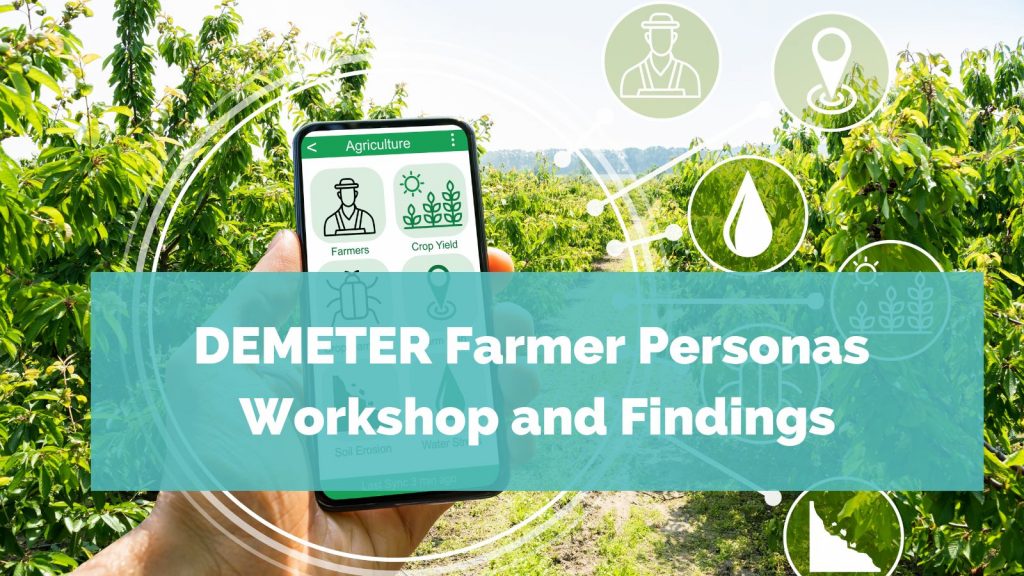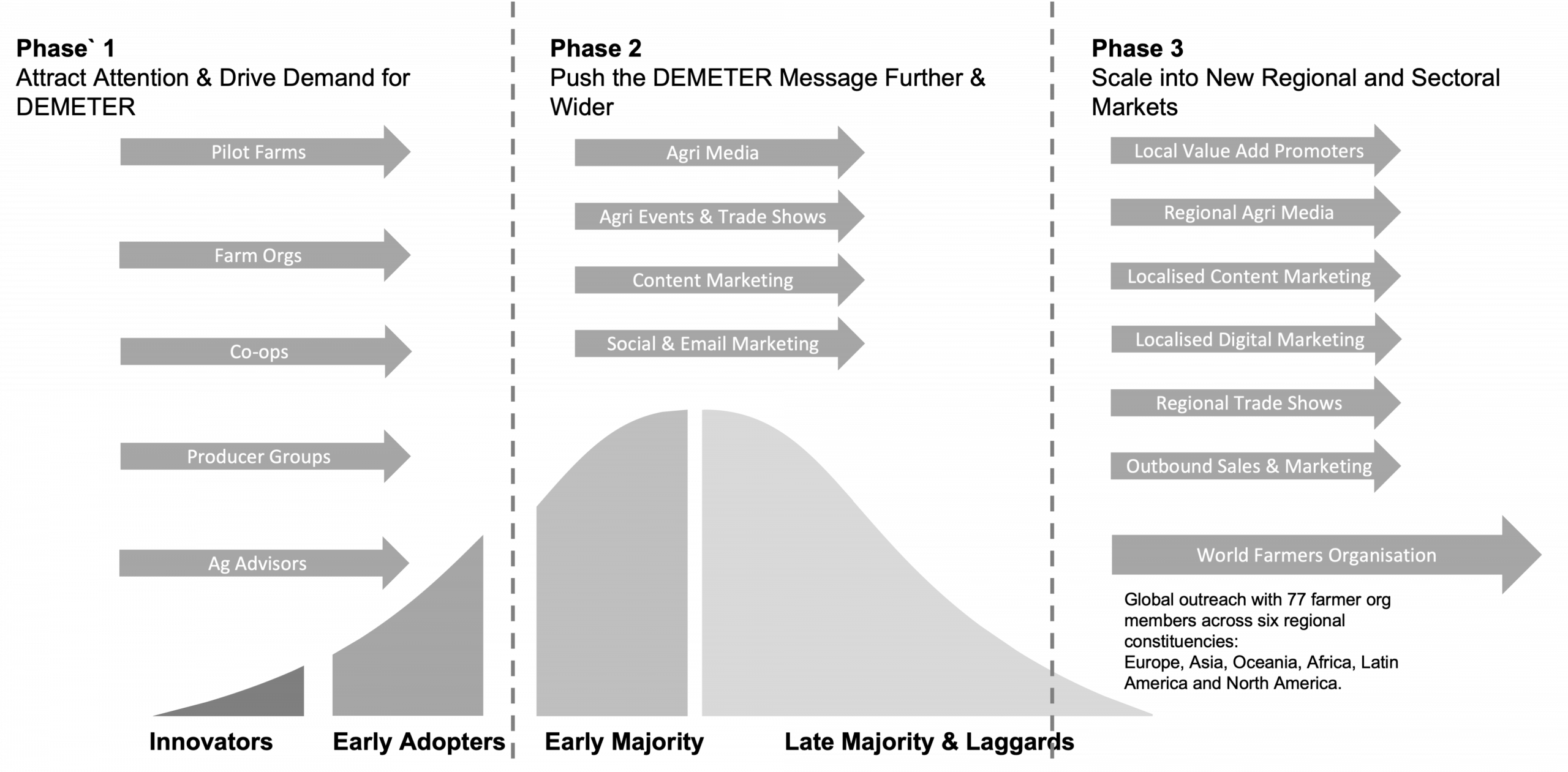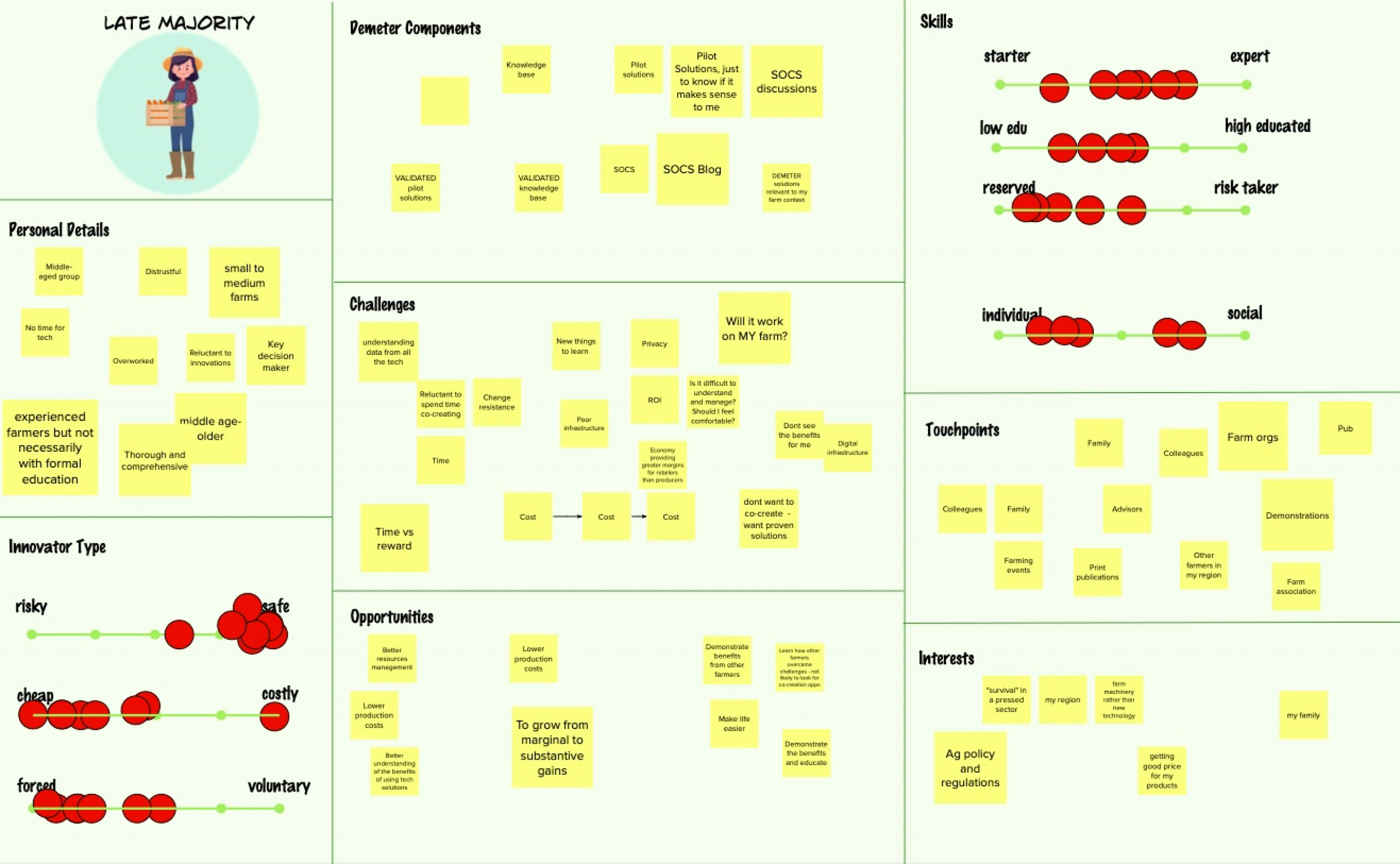
This article was written by Ethan Cleary of the Irish Farmers’ Association
Personas are a useful way to create representations of a set of target users for a product or service. In DEMETER, personas are used to help us better understand the different functional, social, and emotional characteristics and requirements of a widely diverse set of different farm types and production systems. The core objectives are to inform our development roadmap to enhance the product-market fit of DEMETER technologies and to look at refining our marketing and communication strategy to better reach each of the segments represented by the different personas.
The personas were formed through a co-creation workshop involving farmers, farm organisations, researchers, and technology providers who have close relationships with farmers. We grouped the personas to represent the different stages of the technology adoption lifecycle which describes the general pattern of adoption for new technologies and provides us with a useful framework for understanding and predicting the diffusion of new technologies.
| Stages of the General Technology Adoption Lifecycle
Innovators: Early adopters who are technology evangelists and willing to try new and untested products. Early Adopters: People who are willing to adopt new products ahead of the majority and often provide positive feedback to others. Early Majority: The early majority are people who adopt new products after they have been proven successful by the early adopters. Late Majority: The late majority are people who adopt new products only after they have been widely adopted by others. Laggards: People who are last to adopt new products and are often resistant to change. |
Each persona has distinct characteristics, such as age, farm size, technology usage, and adoption drivers. For example, innovators are typically younger, tech-savvy farmers who are willing to experiment with new technologies, while laggards are typically older, traditional farmers who are more comfortable with the status quo. Each of the specific technology components of DEMETER were also analysed across each persona stage looking at the challenges and opportunities that are present.

Figure 1 DEMETER Technology Adoption Lifecycle Model
The workshop was coordinated and run by the Work Package 6 and 7 teams. We applied Multi-Actor Animation (MAA) techniques using video conferencing tools and a shared digital canvas for real-time collaboration. These techniques drove rich participation and delivered a detailed perspective on each of these personas.

Figure 2 Example Collaboration Workspace for Persona Development
After the workshop, we carried out a detailed analysis of the research results and this was then elaborated upon and presented in a more comprehensible format.
Below is a sample of the Early Majority Persona analysis.
| Early Majority | Personal Details
The early majority-farmer shares some of the early-adopter’s ability to relate to Smart Farming Technologies (SFTs), but ultimately they are driven by a stronger sense of practicality. They are more likely to worry that new SFTs will end up as passing fads as opposed to a fundamental part of their farming operation. They are content to adopt a ‘wait and see’ approach and assess how new SFTs work on other similar farms. They want to see well-established evidence and references before investing in new SFTs. The early adopter farmer segment is a large market, making up roughly one-third of the whole adoption lifecycle and “winning” this segment will be key to any substantial adoption and growth for DEMETER. These farmers are typically older than the innovator and early adopter segment, ranging from 35-60. They have less technology education but have deep knowledge and experience in their agricultural production system. Innovator Type These farmers are more risk averse than the early adopter and innovator farmers. They will not invest substantially without strong references from trusted sources, that the technology will yield a Return on Investment (ROI) within a couple of seasons. They are more likely to wait for a technology to be mature and well tested before adopting, and thus are content to wait for regulatory-driven mandates to adopt a new technology. DEMETER Components The DEMETER pilot solutions offer the reference points these farmers look for and should be the foundation for a targeted marketing campaign aimed at early majority-farmers. The SOCS blog, wiki and other information sources should be used to highlight the positive outcomes from the DEMETER pilots and should be easily accessible and quickly located for these farmers. DEMETER Challenges Trust and confidence are two key traits that need to be satisfied to win over this base. These farmers will need to be able to trust recommendations and references from farmers from different countries and different sectors. The early majority-farmers take longer to make a purchasing decision so having regular, updated content on the how DEMETER SFTs are working and impacting farmers in a positive way will need to be prioritised. If we look at SOCS through the 90% – 9% – 1% rule, the innovators are most likely to start new discussions and contribute to the SOCS community (1%), the early-adopters will contribute and respond to other farmers, advisors and technologists (9%) while the early-majority will be happy to read and consume content posted by others and will likely only reach out and ask more detailed questions when they are moving towards making a substantial purchasing decision. DEMETER Opportunities With enough reference points and affirmative feedback from the DEMETER community, the early majority farmer is likely to make a positive adoption decision on a new SFT. A positive reference from the early majority-farmer will hold a lot of weight with other farmers in this cohort and beyond as it offers ‘peace of mind’ in adopting a new SFT. With a positive experience in making their first adoption decision through DEMETER, these farmers are more likely to shift their perceptions and more towards an early majority mindset. Skills These farmers are less likely to have higher education experience than the innovator and early adopter segments but have deep agricultural knowledge specially related to their farm sector and region. They are business oriented and while they are involved in farmer organisations, they will take adoption decisions based on their own research, understanding and instinct. Interests They are more family oriented than the innovator and early adopter segments and work-life balance is important. Any SFT will have to demonstrate clear benefits for their farm business including improving farm performance, reducing administration and expenses, and delivering a better lifestyle. These farmers are likely to be involved in farmer organisations and co-ops but less likely to be in leadership or committee positions. They are aware of national and international agricultural regulations but are content to wait for new SFTs to be incentivised through farm schemes and supports. Touchpoints Family, colleagues, neighbours, advisors, farmer organisations, agri-media and other farmers all play a role in the early majority adoption decision but it is ultimately after the synthesis of all these touchpoints that a decision is made. |
You can access the DEMETER Farmer Personas report here: DEMETER Farmer Persona.
DEMETER’s use of personas in designing digital solutions for farmers has several benefits. Firstly, it helps to ensure that the solutions being developed meet the needs and motivations of our target audience. Secondly, personas provide a common language and understanding for all the DEMETER stakeholders involved in the project. Thirdly, this research will help us in developing the marketing and communication strategy for the larger scale adoption of DEMETER technologies. Finally, these personas can be used to evaluate and improve the solutions over time, ensuring that they remain relevant to DEMETER users.
The DEMETER persona exercise provided valuable insights into the diverse needs and motivations of farmers at the different stages of technology adoption. It highlighted the importance of involving farmers in the design process and the benefits of using personas to develop digital solutions that meet the needs of our farmers.


